Motivation and Wellbeing Test
1/101
Earn XP
Description and Tags
Name | Mastery | Learn | Test | Matching | Spaced |
|---|
No study sessions yet.
102 Terms
What is Motivation?
The conscious or unconscious force leading the behaviours that individuals initiate, direct and maintain
What is a Motive?
The desires behind goal directed behaviour
Why is Motivation Important?
Motivation serves as a guiding force for all human behavior.
What can understanding Motivation do?
Increase your efficiency as you work towards your goal
Drive you to take action
Encourage you to engage in health-oriented behaviors
Help you avoid unhealthy or maladaptive behaviors, such as risk taking and addiction
Help you feel more in control of your life
Improve your overall well-being and happiness
Hormone Control on Motivation - Leptin
In situations where leptin levels are low, such as during periods of energy deficit or in conditions like obesity where leptin resistance occurs, individuals may experience reduced motivation due to decreased energy levels and overall fatigue
Hormone Control on Motivation - Ghrelin
In situations where ghrelin levels are high, such as during fasting or calorie restriction, individuals may experience increased motivation to seek out food as a means of obtaining energy.
Hormone Control on Motivation - Insulin
Balanced insulin levels are associated with stable blood glucose levels, which provide a steady source of energy to support cognitive function and motivation. Where insulin resistance or dysregulation occurs, fluctuations in blood glucose levels can affect mood and energy levels, impacting motivation.
Physiological Forces
Innate, biological, and must be met in order for you to survive.
Necessary for survival and motivate most human behaviour
Examples of Physiological Needs
Hunger, thirst, the need for sleep which are all regulated by your body’s internal systems
Cognitive Forces
Motivation derived from cognitions include intellectual challenges, due to intrinsic satisfaction they produce, and the drive to satisfy curiosity and explore personal interests.
E.g. Personal values an individual holds, their goals in life and their expectations
Intrinsic vs extrinsic motivation
Emotional Forces
Emotional motivation can stem from trying to avoid pain and finding happiness
Dependent on positive vs negative emotions, e.g. fear, anger, or happiness.
For example, we may feel anxious before a big meeting or exam because we understand that the outcome would greatly affect us. Thus, as a result of the anxiety we experienced, we might be more likely to study harder. The motivation comes as a direct result of the emotions that we experienced.
Social Forces
People have the need to be with other people, which is what drives humans to develop social relationships and belong to groups.
It is a learned psychological drive that we gain through our family, society, and cultural upbringing.
Example peer pressure, conforming to social norms and receiving approval from others
Social Support & Feedback - Emotional Support
Social support from friends, family, colleagues, mentors, or support groups can offer emotional reassurance and empathy during challenging times.
Knowing that others care about our well-being and believe in our abilities can boost confidence and resilience, helping us stay motivated even in the face of setbacks or obstacles.
Social Support & Feedback - Encouragement and Validation
Positive feedback and encouragement from others can reinforce our efforts and accomplishments, validating our progress and boosting self-esteem.
Hearing praise or recognition for our achievements can provide a sense of validation and affirmation, reinforcing our intrinsic motivation to pursue our goals
Social Support & Feedback - Guidance and Advice
Social support networks can offer valuable guidance, advice, and perspective, helping us navigate obstacles, make informed decisions, and overcome challenges more effectively.
Seeking input from others who have faced similar situations or possess relevant expertise can provide valuable insights and strategies for success, enhancing our motivation and confidence.
Social Support & Feedback - Accountability and Motivation
Sharing our goals and progress with others can create a sense of accountability, motivating us to follow through on our commitments and stay on track.
Knowing that others are aware of our goals and expectations can create a sense of obligation to perform, increasing our motivation to achieve desired outcomes and avoid disappointing others.
Social Support & Feedback - Social Comparison and Inspiration
Observing the achievements and progress of others can serve as a source of inspiration and motivation, providing tangible examples of what is possible and encouraging us to strive for similar levels of success.
Social comparison with peers who are pursuing similar goals can foster a sense of camaraderie and healthy competition, motivating us to challenge ourselves and push beyond our comfort zones.
Social Support & Feedback - Constructive Feedback and Learning
Constructive feedback from others can provide valuable insights into areas for improvement, helping us identify strengths and weaknesses and refine our approach to achieving our goals.
Embracing feedback as an opportunity for growth and learning can fuel our motivation to continually strive for excellence and mastery in our endeavours.
Self Determination Theory - Deci and Ryan (1985)
The motivation behind the decisions that people make when not being influenced externally
Prior to this, it was believed that people perform behavior for the sole purpose of being rewarded.
Their theory outlined the concepts of amotivation, intrinsic motivation and extrinsic motivation as well as the 3 psychological needs for motivation.
Assumptions of Self Determination Theory
The need for growth drives behavior. The first assumption of self-determination theory is that people are actively directed toward growth. Gaining mastery over challenges are essential for developing a cohesive sense of self.
Autonomous motivation is important. self-determination theory focuses primarily on internal sources of motivation such as a need to gain knowledge or independence (intrinsic motivation).
Psychological Needs for Motivation
Autonomy, Competence, Relatedness
Autonomy (Non-Self Determined)
Autonomy is a need for people to feel in control of their own behaviours and goals
Autonomy needs can be met by having other people acknowledge your feelings
Tangible rewards can also reduce feelings of autonomy.
Satisfying this need improves well being and leads to increased motivation
Competence
Competence is a need for people to gain mastery of tasks and learn different skills and experiencing a sense of achievement.
Competence needs can be met by being given tasks that are challenging but not overwhelming.
Competence needs can be met by receiving positive feedback
If tasks are too challenging or a person receives negative feedback, feelings of competence can decrease.
Satisfying this need increases the likelihood an individual will feel satisfaction from overcoming obstacles and engaging in their pursuits
Relatedness
Relatedness people need to experience a sense of belonging and attachment to other people
Relatedness is the ability to feel a sense of attachment to other people
Without connections, self-determination is harder to achieve because the individual would lack access to both help and support.
Feelings of relatedness are enhanced when individuals are respected and cared for by others, and are part of an inclusive environment.
Alternatively, feelings of relatedness are undermined by competition with others, cliques, and criticism from others.
Fulfilling this need contributes to overall wellbeing
Self Determination Theory- Deci & Ryan (1985)
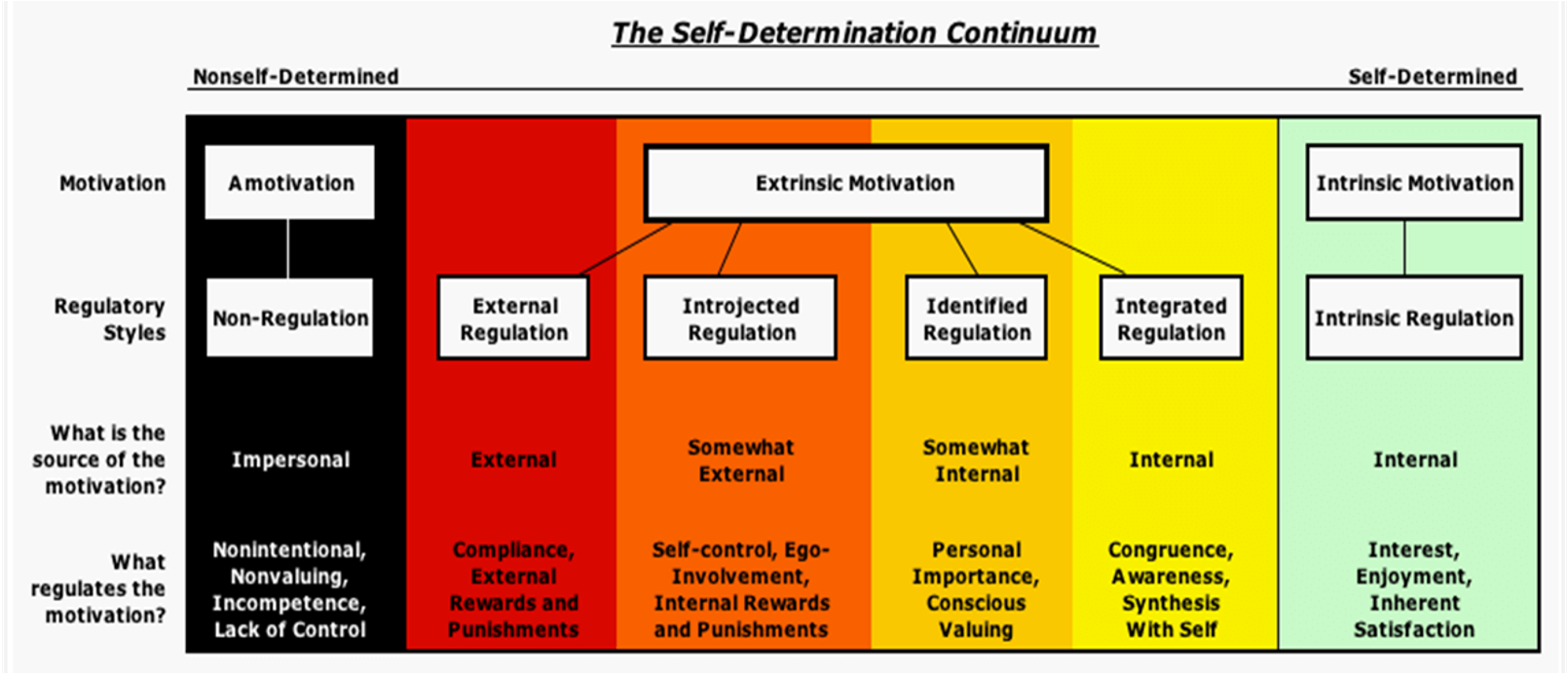
Amotivation
The lack of intrinsic or extrinsic motivation
People have become amotivated towards a behaviour when the environment does not allow for the behaviour to be carried out competently
Individuals may feel disconnected from the activity or perceive it as irrelevant, leading to a lack of effort or engagement.
Extrinsic Motivation
Motivation driven by external rewards
These consequences can be tangible, such as monetary loss, or abstract, such as social respect or shame.
Consequences can also be a receiving a reward or a negative consequence such as a punishment if they do not complete a task
The rewards reduce self determination/intrinsic motivation (as it reduces autonomy).
This motivation is a means to an end.
Types of Extrinsic Motivation - Reward-Based Motivation
Reward-based motivation describes motivation resulting from external rewards, tangible or abstract
Types of Extrinsic Motivation - Power-Based Motivation
Power-based motivation is a form of extrinsic motivation reliant upon the desire to exert control over others.
Types of Extrinsic Motivation - Fear-Based Motivation
Fear-based motivation describes the desire to avoid an extrinsically negative result
Intrinsic Motivation
Driven by an inner desire for self satisfaction arising from achieving specific goals.
When intrinsically motivated, a person is moved to act for the fun or challenge entailed rather than because of external products, pressures, or rewards.
Researchers identified several different types of intrinsic motivation -4Cs
Intrinsic Motivation - Challenge
People seek out challenges and new skills to master solely because of the pleasure of accomplishment
Intrinsic Motivation - Curiosity
Other forms of motivation involving learning as inherent to people’s constant process of getting to know their worlds
Intrinsic Motivation - Control
The motivational value of having a sense of control
Intrinsic Motivation - Context
The importance of contextualizing learning to the larger world
Self - Determined Behaviours
Motivated by intrinsic rewards
Driven by enjoyment, interest or satisfaction
Feels in control
Non Self-Determined Behaviours
Motivated by extrinsic rewards
Driven by obligation or responsibility
Feel a lack of control
Traits of Self Determined People
Believe that they have control over their own lives.
Have high self-motivation.
Base their actions on their own goals and behaviours.
Take responsibility for their behaviours.
Self-Determination Theory - Strengths
Supported by a range of evidence
Many uses including the workplace environment
Theory is widely applicable across different cultures and contexts
Self-Determination Theory - Limitations
Lacks falsifiability (cannot prove or disprove the theory - explains not predicts behaviour).
The multiple components within the theory are complex and may limit the ability to not only comprehend the theory but to apply it
Maslow’s Hierarchy of Needs
According to Maslow human needs were arranged in a hierarchy, with physiological (survival) needs at the bottom, and the more creative and intellectually oriented ‘self-actualization’ needs at the top.
Maslow argued that survival needs must be satisfied before the individual can satisfy the higher needs.
The higher up the hierarchy, the more difficult it is to satisfy the needs associated with that stage, because of the interpersonal and environmental barriers that inevitably frustrate us.
Higher needs become increasingly psychological and long-term rather than physiological and short-term, as in the lower survival-related needs.
Hierarchy of Needs
The order of needs may vary amongst individuals and people can be motivated by more than 1 need simultaneously
There is continual movement up and down the hierarchy as partially or fully satisfied needs may become threatened and require attention
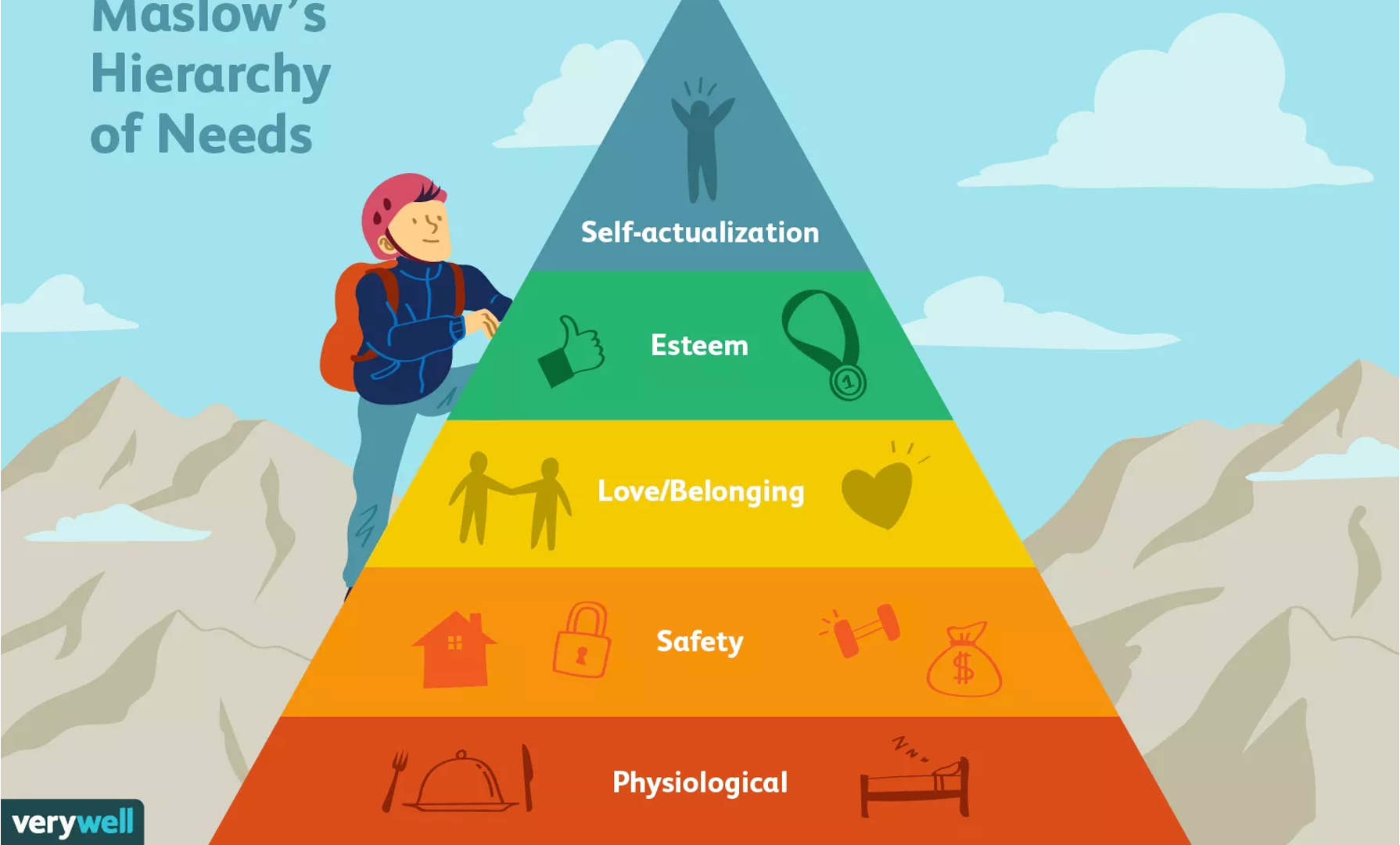
Needs & Motivation
This five-stage model can be divided into deficiency needs and growth needs.
The first four levels are often referred to as deficiency needs (D-needs), and the top level is known as growth or being needs (B-needs).
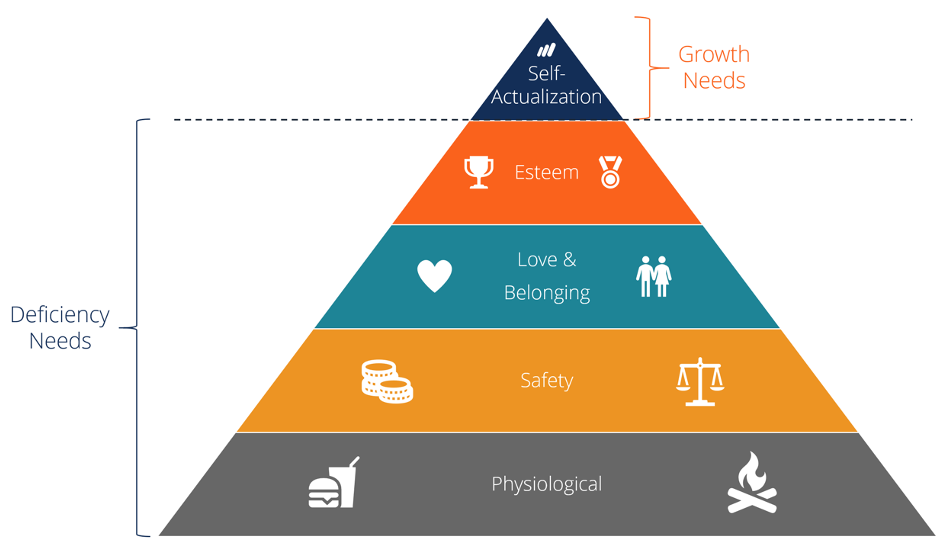
Deficiency Needs
Deficiency needs are concerned with basic survival and include physiological needs (such as the need for food and sleep) and safety needs (such as the need for security and freedom from danger).
Behaviours associated with these needs are seen as ‘deficiency’ motivated, as they are a means to an end.
Deficiency needs arise due to deprivation and are said to motivate people when they are unmet.
Also, the motivation to fulfill such needs will become stronger the longer they are denied. For example, the longer a person goes without food, the hungrier they will become.
Level 1: Physiological Needs
Are biological requirements for human survival, e.g., air, food, drink, shelter, clothing, warmth and sleep.
Maslow considered physiological needs the most important as all the other needs become secondary until these needs are met.
Our most basic need is for physical survival, and this will be the first thing that motivates our behaviour.
Once that level is fulfilled, the next level up is what motivates us, and so on.
Level 2: Safety Needs
People want to experience order, predictability, and control in their lives.
Safety needs can be fulfilled in multiple ways, by the family and society (e.g., police, schools, business, and medical care).
For example, emotional security, financial security (e.g., employment, social welfare), law and order, freedom from fear, social stability, property, health, and wellbeing (e.g., safety against accidents and injury).
Level 3: Love and Belongingness
Human emotional need for interpersonal relationships, affiliating, connectedness, and being part of a group.
Examples of belongingness needs include friendship, intimacy, trust, acceptance, receiving and giving affection, and love.
This need is especially strong in childhood and can override the need for safety, as witnessed in children who cling to abusive parents.
Level 4: Esteem
Maslow classified esteem needs into two categories:
Esteem for oneself (dignity, achievement, mastery, independence)
The desire for reputation or respect from others (e.g., status, prestige).
Esteem presents the typical human desire to be accepted and valued by others. People often engage in a profession or hobby to gain recognition. These activities give the person a sense of contribution or value.
Maslow indicated that the need for respect or reputation is most important for children and adolescents and precedes real self-esteem or dignity.
Growth Needs
Growth needs are more psychological and are associated with realizing an individual’s full potential and needing to ‘self-actualize’.
These needs are achieved more through intellectual and creative behaviours.
Growth needs do not stem from a lack of something but rather from a desire to grow as a person.
Once these growth needs have been reasonably satisfied, one may be able to reach the highest level, called self-actualization. Growth needs are achieved more through intellectual and creative behaviours.
Level 5: Self Actualisation
Achieving one’s full potential
Highest level in Maslow’s hierarchy, and refer to the realization of a person’s potential, self-fulfilment, seeking personal growth, and peak experiences.
The desire to accomplish everything that one can, and “to become everything one is capable of becoming”.
Self-Actualised People
Maslow (1970) estimated that only two percent of people would reach the state of self-actualization.
He was especially interested in the characteristics of people whom he considered to have achieved their potential as individuals.
By studying 18 people, he considered to be self-actualized (including Abraham Lincoln and Albert Einstein), Maslow (1970) identified 15 characteristics of a self-actualized person.
Characteristics of Self-Actualised People
They perceive reality efficiently and can tolerate uncertainty
Accept themselves and others for what they are
Spontaneous in thought and action
Problem-centred (not self-centred)
Unusual sense of humour
Able to look at life objectively
Highly creative
Resistant to enculturation, but not purposely unconventional
Concerned for the welfare of humanity
Capable of deep appreciation of basic life-experience
Establish deep satisfying interpersonal relationships with a few people
Peak experiences
Need for privacy
Democratic attitudes
Strong moral/ethical standards.
Expanded Hierarchy of Needs - Deficiency
Stays the same
Level 5: Cognitive Needs
Knowledge and understanding, curiosity, exploration, need for meaning and predictability.
Cognitive needs drive our pursuit of knowledge and understanding. For instance, a student’s desire to understand complex mathematical theories, a traveller's curiosity about diverse cultures, or an individual’s quest for life’s deeper meanings all exemplify these needs.
Meeting these needs facilitates personal growth, comprehension, and a deeper understanding of life and its complexities.
Level 6: Aesthetic Needs
Appreciation and search for beauty, balance, form, etc.
Fulfilling these needs leads to a deeper sense of satisfaction and harmony in life, as individuals seek environments and experiences that are pleasing and resonant with their sense of beauty.
This involves the appreciation and pursuit of art, music, nature, and other forms of aesthetic expression.
Fulfilling these needs isn’t just about physical beauty but also the emotional and psychological satisfaction derived from experiencing order and elegance.
Level 7: Self Actualisation
stays the same
Level 8: Transcendence
A person is motivated by values that transcend beyond the personal self. Beyond self-actualization, they represent the human desire to connect with a higher reality, purpose, or the universe.
This level emphasizes altruism, spiritual connection, and helping others achieve their potential.
Examples of transcendence needs include mystical experiences and certain experiences with nature, aesthetic experiences, sexual experiences, service to others, the pursuit of science, religious faith, etc.
Maslow’s Hierarchy of Needs - Strengths
Focused on healthy human psychological development which was uncommon at the time.
The humanistic concept that individuals have the capacity to undergo personal growth is supported by other studies. Results from these studies revealed that the Transcendental Meditation, a variant of yoga, was associated with significant progress towards self actualization in patients.
Maslow’s Hierarchy of Needs - Limitations
The sample of participants Maslow interviewed was small purposefully selected to be made up of those he believed to have self actualized. No objective measures were used to gather his information, only subjective measures.
The hierarchical categorization of needs oversimplifies complex human behaviour and may not be the most suitable structure for describing Maslow's theory.
While Maslow never described a pyramid shape, this assumption has been made by many and fuels idea of neatly compared to mentalize needs that are independent from each other.
How the Self Determined Theory Affects Wellbeing
Individuals are motivated by three key psychological needs
Autonomy – Sense of control
Competence – belief in one’s ability to achieve desired goals
Relatedness – closeness and belonging with others
Important points:
Autonomy is critical to behaviour being self determined
Satisfaction of these needs is related to wellbeing
Subjective Wellbeing
The mixture of negative and positive measures and overall emotional (Affective balance) and cognitive (Life satisfaction) assessment of life that is personal to an individual
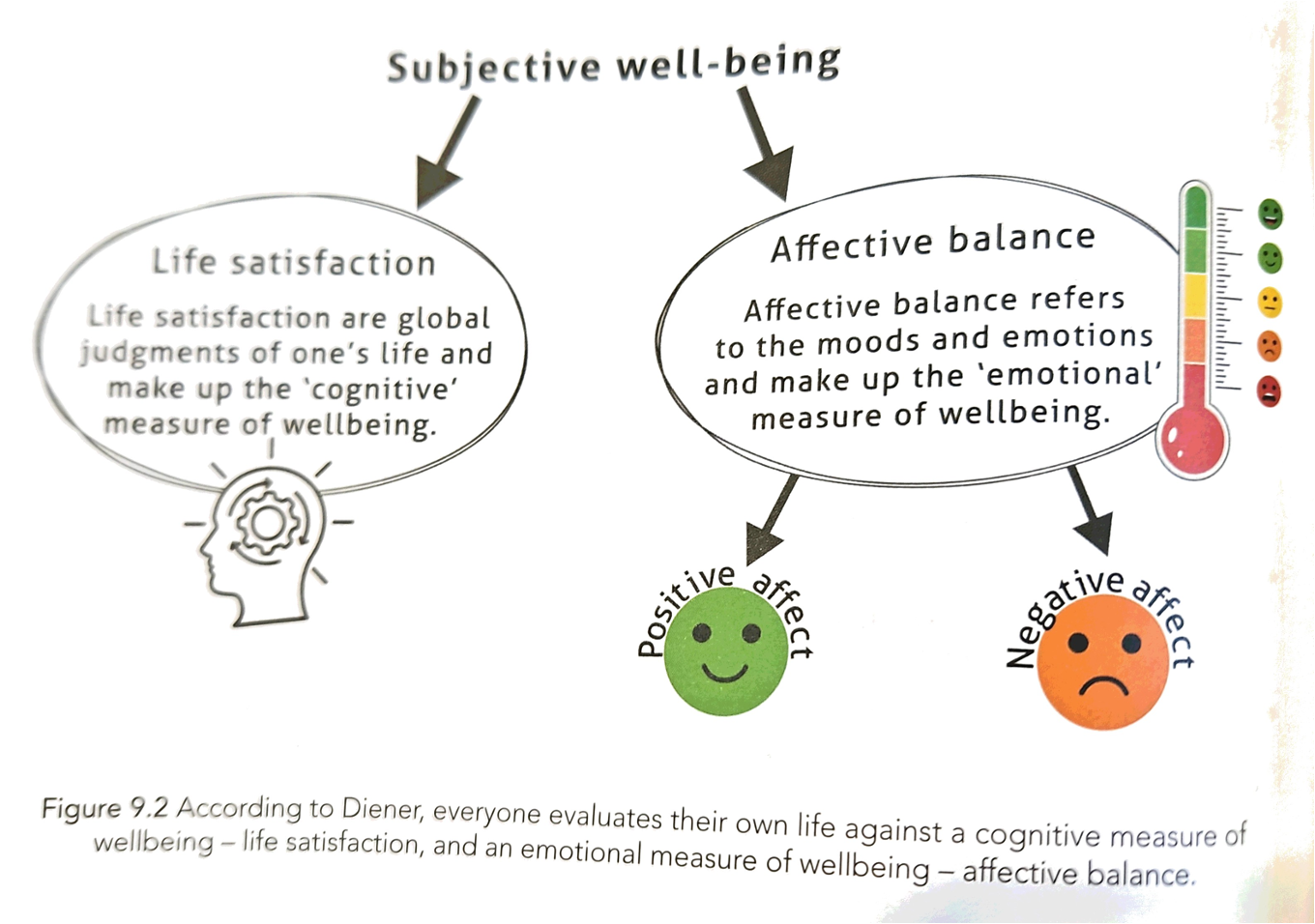
Model of Subjective Wellbeing – Diener 1984
Subjective wellbeing (SWB) relies on one's evaluation of their life. – hence ‘ subjective to each person
There are three main components
Frequent positive affect
Infrequent negative affect
General life satisfaction
Having all three components makes it more likely for a person to experience subject well being
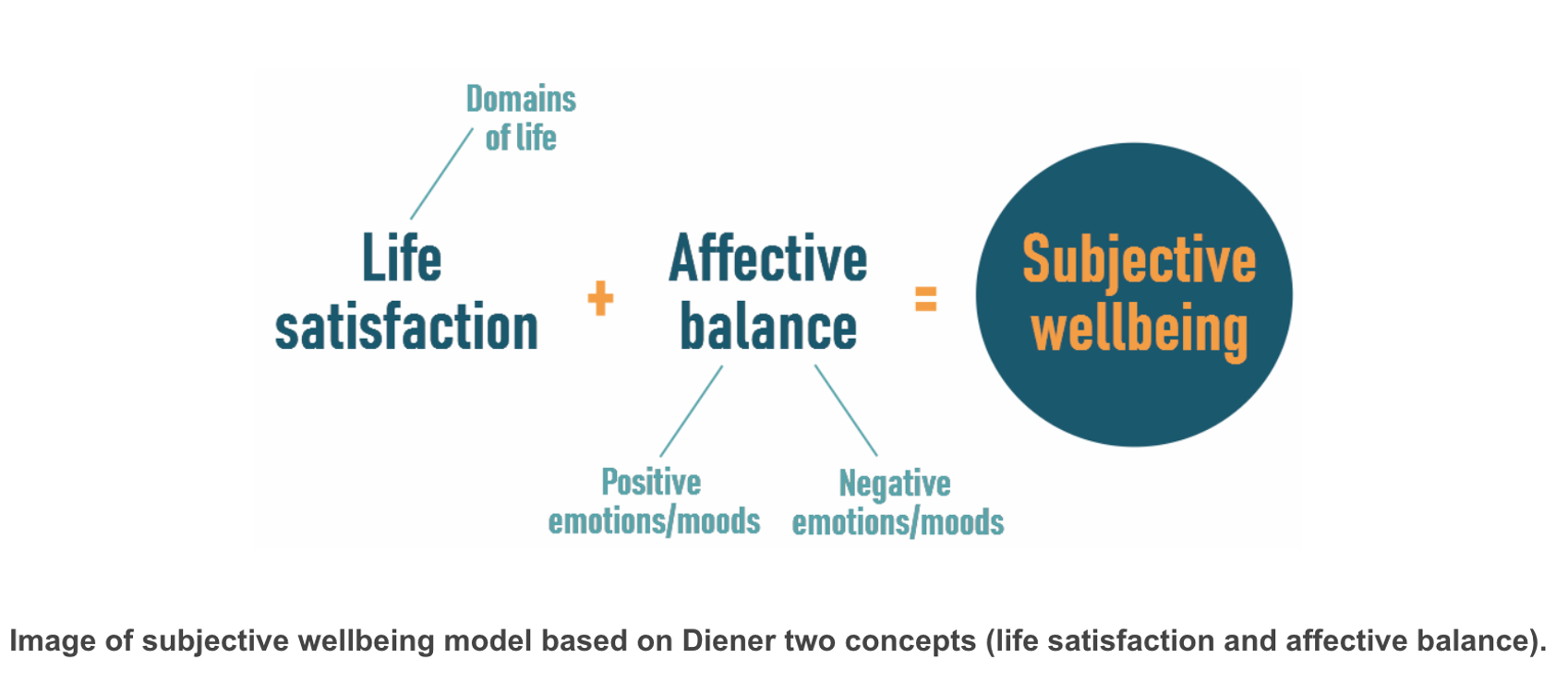
Life Satisfaction (Cognitive Measure)
About the judgements a person makes
Global assessment of one's life and whether each domain (e.g. school, family) provides fulfilment.
Satisfaction will greatly rely on cultural influences and personal characteristics.
The most influential life satisfaction across individuals and cultures may be the ones closest to the individual.
Someone's overall feeling often impacts their life satisfaction e.g. happy people tend to remember more positive events in their lives rather than negative ones
Affective Balance
Represents the ratio of all your positive and negative emotions and moods
Emotions are short and intense,
Moods last longer and are less charged in intensity.
Diener (1984) hypothesises that SWB is both the process of reducing negative affect and increasing positive affect (while being satisfied with life).
One affect excludes the other: if you're in a period of positive affect, you are unlikely to experience negative affect simultaneously.
The frequency of positive and negative affect is crucial in determining the overall ratio.
The link between emotional state and life satisfaction suggests that affective balance is significant in SWB
Affect
The experience and outward expression of emotions
Positive Affect
Pleasant emotions such as happiness, excitement, joy and contentment
Negative Affect
Distressing emotions such as anger and sadness
Factors Influencing Subjective Wellbeing - Socioeconomic Status
Economic stability, income level, and job satisfaction impact SWB. Higher income generally correlates with higher SWB, but only up to a certain point.
Factors Influencing Subjective Wellbeing - Relationships
Quality of social relationships, including family, friends, and romantic partners, is crucial for high SWB.
Factors Influencing Subjective Wellbeing - Physical Health
Physical health and lifestyle choices, such as exercise and diet, are strong predictors of SWB.
Factors Influencing Subjective Wellbeing - Cultural Factors
Cultural background influences values, norms, and expectations, which affect SWB.
Factors Influencing Subjective Wellbeing - Environmental Factors
Living environment (urban vs. rural, safety, green spaces) affects SWB
Factors Influencing Subjective Wellbeing - Genetic Factors
Genetics play a role in predisposition to higher or lower SWB, although environment and personal choices are also significant
Factors Influencing Subjective Wellbeing -Personality Traits
(e.g., extraversion, neuroticism) significantly influence SWB
Model of Subjective Wellbeing – Diener 1984 - Strengths
Has cultural universality
Applicable across multiple cultural contexts as its main components, lie satisfaction and affective balance, can be applied to different cultures.
This model is a comprehensive and holistic approach to wellbeing due to the three components it entails
Model of Subjective Wellbeing – Diener 1984 - Limitations
External factors also affect wellbeing, yet these are not considered in this model . This model mainly focuses on the emotions and personal experiences of the individual.
Examples of external factors include social relationships, finances, work conditions and cultural influences.
Uses self report measures, which means individuals may exaggerate their responses to seem socially desirable.
Model of Subjective Wellbeing – Diener 1984 - Applications
Effectiveness of public health initiatives and polices can be guided and assessed using subjective wellbeing measures.
Administering subjective well being surveys provide policy makers with data that can be used to compare the wellbeing of targeted populations before and after initiatives have been put in place.
Models of Psychological Wellbeing -Ryff
Ryff evaluated aspects of positive psychological functioning within numerous theories of maturity, self actualization, lifespan development, positive mental health, individuation, and the fully functioning person.
The overlapping concepts across these theories developed into the six factors of wellbeing
Ryff was not satisfied with previous theories developed the Psychological Wellbeing Scale based on her theory.
She wrote high and low dimensions for each factors (higher scores indicated greater wellbeing for that factor)
Her theory is applicable for a range of ages and demographics
Six Factor model of Wellbeing - Self Acceptance
Acknowledgement of personal strength and weaknesses, and past decisions and behaviours.
Positive attitude toward the self; acknowledgment and acceptance of multiple aspects of self, including good and bad qualities; positive feelings about one’s past
Six Factor model of Wellbeing - Positive Relations with Others
Individuals find importance in forming genuine relationships with others and guiding the younger generation.
Warm, satisfying, trusting relationships with others; concern for the welfare of others; capacity for strong empathy, affection, and intimacy; understanding of the give-and-take of relationships
Six Factor model of Wellbeing - Autonomy
Individuals seeking personal evaluation not from others but from within themselves and their own standards.
Self-determination and independence; the ability to resist social pressures to think and act in particular ways, regulate behaviour from within, and evaluate oneself based on personal standards
Six Factor model of Wellbeing - Environmental Mastery
Manipulating surroundings to best suit personal needs(not accepting things as they are)
Sense of mastery and competence in one’s environment; the ability to control a complex array of external activities and leverage opportunities; the capacity to choose or create contexts that suit needs and values
Six Factor model of Wellbeing - Purpose in Life
Meaning in life evolves over time, requiring individual to reevaluate intention and direction
The possession of goals and a sense of direction; the feeling that there is meaning to present and past life; holding beliefs that give life purpose as well as aims and objectives for living
Six Factor model of Wellbeing - Personal Growth
Utilising past and present experiences allows one to continually develop as a person
Feelings of continued development and the sense that one is growing and expanding; openness to new experiences; realization of one’s potential and perceived improvement in self and behavior over time; change that reflects greater self-knowledge and effectiveness
Autonomy - High Score
Are independent and self-determining; have internal ways to regulate their behaviour.
Can resist social pressure and conformity
Assess themselves with personal standards
Autonomy - Low Score
Are concerned with others’ opinions (e.g. expectations)
Need other’s approval to make important decisions
Conform to social norms
Environmental Mastery - High Score
Feels confident in manipulating their environment
Manages complicated tasks
Makes the most of situations that they find themselves in
Environmental Mastery - Low Score
Lack a sense of control over external conditions
Find it difficult to manage their day-to-day activities
Feel powerless to change or improve their environment
Can’t perceive opportunities
Self-Acceptance - High Score
Have a positive outlook on both good and bad characteristics of themselves
Feel at peace with their past
Has high self-esteem
Self-Acceptance - Low Score
Are dissatisfied with themselves and/or their past life
Want to be different from who they are
Has low self esteem
Positive Relationships - High Score
Have safe, warm, satisfying relationships
Can show empathy and concerns for others, as well as intimacy and affection
Understand that human relationships need reciprocity and compromises
Positive Relationships - Low Scores
Have limited close relationships
May be unable to be open and concerned about others
Are isolated and find it difficult to understand relationships and/or compromise
Personal Growth - High Score
See themselves as continuously developing
Perceive their own improvements over time
Are self aware and may change their behaviour because of this self- awareness
Are open to new experiences
Have a sense of fulfilment towards their true potential
Personal Growth - Low Score
Feel stuck
Feels a sense of stagnation due to a lack of personal improvement over time
Feel uninterested and bored with life
Are unable to track their progress
Purpose in Life - High Score
Have goals and a sense of meaning to their past and present lives
Hold beliefs that give purpose to their lives
Purpose in Life - Low Score
Have a limited sense of meaning in life
Lack a sense of direction and goals or aims
Are unable to see a purpose or an overall meaning to life
6 Factor Theory
Ryff reviews how these components of wellbeing can vary across gender and age groups, as well as cultural backgrounds.
Gender
Women score themselves higher than men in terms of positive relationships and personal growth. There are no significant differences in regard to the other components.
Age
Overall, environmental mastery and autonomy increase with age. On the contrary, personal growth and life purpose decrease, particularly from midlife to old age. There are no significant patterns for the remaining components, positive relationships and self-acceptance. However, Ryff notes that these results are based on very specific groups, therefore, lack generalisability.
Culture
Self-oriented values should be more significant in individualistic societies (e.g. Western countries) than in collectivist ones (e.g. Eastern nations). A comparison between midlife adults in the U.S. and South Korea found consistent results. For instance, South Koreans scored higher on positive relationships, while Americans attributed the best scores to personal growth.
Models of Psychological Wellbeing -Ryff - Strengths
Previous research on wellbeing, lacked specific detail on psychological wellbeing and instead focused solely on life satisfaction and affect. This model encompasses multiple dimensions of wellbeing including self-acceptance, the recognition of personal abilities and the capacity for personal growth.
Not only is the model theory-based but it is also supported empirically via the PWB scale. The PWS has been found to have high reliability and validity, thus is a credible assessment tool.
Models of Psychological Wellbeing -Ryff - Limitations
Additional factors that influence wellbeing are not accounted for in detail in the model, such as social and economic factors.
There is a strong emphasis on positive aspects of well-being and minimal consideration for negative affect and the ways in which people are able to cope with adversity and hardships.
One limitation of the Ryff scales is that it relies on self-reported assessments of psychological well-being. As with all self-report instruments, students may respond in ways that are socially desirable rather than reveal their actual response to each statement.
Models of Psychological Wellbeing -Ryff - Application
The PWB developed by Ryff has been used to explore ways in which the quality of sleep impacts psychological wellbeing.
Research has shown that people with optimal sleep indicated higher levels of personal growth, purpose in life, environmental mastery, self acceptance and positive relations with others.
These results demonstrate the relationship between sleep quality and the management of stress and self regulation.